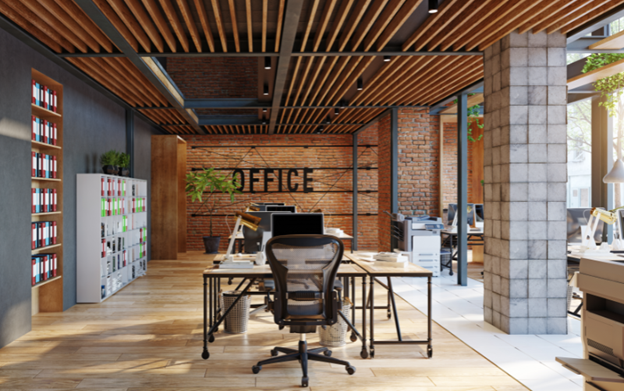Incorporating eco-friendly materials into office interior design not only supports sustainability but also enhances the workspace’s overall atmosphere. As businesses increasingly adopt green practices, choosing materials that are both sustainable and aesthetically pleasing becomes essential. This article highlights key materials for creating an eco-friendly office interior design, ensuring that your workspace is not only stylish but also environmentally responsible.
1. Recycled and Reclaimed Wood
Recycled and reclaimed wood offers a sustainable alternative to newly harvested timber. Using wood from old buildings or furniture reduces waste and the demand for virgin resources. This material adds character and warmth to office interiors while contributing to a lower environmental footprint. It is ideal for creating stylish desks, shelving, and flooring, providing both function and a unique aesthetic.
2. Low-VOC Paints
Volatile Organic Compounds (VOCs) are harmful chemicals in conventional paints and finishes. Opting for low-VOC or zero-VOC paints significantly improves indoor air quality reducing the environmental impact of your office design. These paints come in a wide range of colours and finishes, making them suitable for various design preferences while supporting a healthier workspace.
3. Bamboo Flooring
Bamboo is a rapidly renewable resource that grows much faster than traditional hardwoods. It is an excellent choice for eco-friendly office flooring due to its sustainability and durability. Bamboo flooring is not only environmentally friendly but also provides a modern, sleek look to any office space. Its resilience and ease of maintenance make it a practical option for high-traffic areas.
4. Recycled Glass Surfaces
Recycled glass is an innovative material for countertops, tiles, and decorative accents. By reprocessing glass bottles and jars, manufacturers create surfaces that are both visually striking and sustainable. These surfaces often feature unique, colourful patterns that can enhance the aesthetic appeal of office interiors while supporting waste reduction efforts.
5. Natural Fibre Carpets
Natural fibre carpets, such as those made from wool, sisal, or jute, offer an eco-friendly alternative to synthetic options. These materials are biodegradable and often produced with minimal environmental impact. Natural fibre carpets provide comfort and durability, and their natural textures add an organic touch to office spaces. Additionally, these carpets are often free from toxic chemicals, contributing to better indoor air quality.
6. Cork Flooring
Cork is another sustainable flooring material with a host of eco-friendly benefits. It is harvested from the bark of cork oak trees and regenerates over time without harming the tree. Cork flooring is resilient, comfortable underfoot, and naturally resistant to pests and moisture. Its sound-absorbing qualities make it an excellent choice for creating a quiet and comfortable office environment.
7. Eco-Friendly Fabrics
Selecting fabrics made from organic or recycled materials is crucial for eco-friendly office interiors. Fabrics such as organic cotton, hemp, and recycled polyester are produced with lower environmental impact than conventional textiles. These materials are suitable for office furniture upholstery, curtains, and other soft furnishings, offering sustainability and style.
8. Green Wall Systems
Green walls, also known as living walls, are a sustainable design feature that incorporates plants into vertical spaces. These systems improve indoor air quality, reduce noise levels, and create a calming environment. By integrating green walls into office interiors, you not only enhance the aesthetic appeal but also promote a healthier and more pleasant workspace.
9. Sustainable Lighting Solutions
Energy-efficient lighting solutions, such as LED lights, contribute to an eco-friendly office interior design by reducing energy consumption. LEDs have a longer lifespan and use less electricity than traditional incandescent bulbs, leading to lower utility costs and less environmental impact. Incorporating natural light through well-placed windows and skylights further enhances the sustainability of the office design.
10. Upcycled and Repurposed Materials
Using upcycled and repurposed materials is a creative way to incorporate sustainability into office interiors. Items that have been given a new lease on life, such as furniture made from repurposed industrial components or decorative elements crafted from recycled materials, add a unique character to the office while supporting waste reduction.
In conclusion, incorporating these essential materials into your office interior design supports sustainability and enhances the overall aesthetic of the workspace. By choosing recycled, reclaimed, and natural materials, you contribute to a healthier environment and create an inspiring and functional office space.
For more information about essential materials for eco-friendly office interior design, contact sustainable office interior design experts today.








